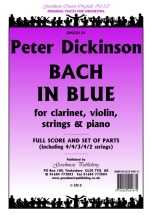Bach in Blue
Buy this item (out of stock)
Product ID: GM2 CO125
By Peter Dickinson
Publisher:
Goodmusic
Arranger:
Clarinet in Bb, Solo Violin, Piano, Strings (Violin 1, Violin 2, Viola, Cello, Bass 4/4/3/4/2)
Series:
Goodmusic Concert Originals
Genre:
2
Line Up:
String Orchestra (Solo: Clarinet & Piano)
Duration:
5:30
Level: 3
Study Score
This item is out of stock
About this item
Bach in Blue for piano (composed 2004) - arranged for clarinet, violin, piano and strings (2015).
As
a piano solo, this piece was one of a number of tributes to Michael
Berkeley in his tenth and final season as Director of the Cheltenham
Festival. Llyr Williams gave the premiere at the Pittville Pump Room on
10th July 2004. There are now recordings of it as a piano solo (played
by the composer) and also for violin, clarinet and piano (the Verdehr
Trio). Several composers, notably Gounod and later Arvo Part, have
become involved with this first prelude in Bach's 48. I had often felt
that there must be a blues lurking somewhere beneath Bach's chords and I
found it here.
Instrumentation
Clarinet in Bb, Solo Violin, Piano, Strings (Violin 1, Violin 2, Viola, Cello, Bass 4/4/3/4/2)
Reviews and rating
No review available, be the first to write one!

Composer
Peter Dickinson 1934
Peter Dickinson is an English composer, musicologist, and pianist.
He was born in Lytham St Annes, Lancashire, and studied organ at Queens' College, Cambridge, where he was a student of Philip Radcliffe. In 1958 he became a student at the Juilliard School in New York City, and studied with Bernard Wagenaar, and encountered the works of experimental composers such as Cowell, Cage, and Edgard Varèse. Returning to England in 1962, he established courses in improvisation and experimental music at the College of St. Mark and St. John, Chelsea. After a lectureship at Birmingham (1966–1970), he became the first professor of music at Keele University in 1974, where he created an important center for the study of American music. He held that position until 1984.
His musical compositions include experimental and aleatoric elements, and are compared to works by Stravinsky, Ives and Satie. Other influences include the music of John Cage, as well as ragtime, blues, and jazz. He layers both serious and popular musical styles together to create what he calls a style modulation. The composer explained his interest in combining musical styles: "Ever since hearing live performances of Charles Ives in New York in the late 1950s and first meeting John Cage there, I have been interested in the effect of hearing different types of music simultaneously." His layering is achieved in a different manner to William Bolcom's "aggressively parodic and deconstructive manner", using more of a "genuine warmth of enthusiasm for the material he is exploiting which suggests something closer to a homage."
More info about the composer...



 Click above to view samples
Click above to view samples
